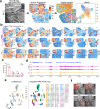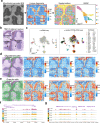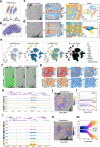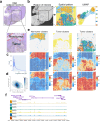Spatial profiling of chromatin accessibility in formalin-fixed paraffin-embedded tissues
- PMID: 40595535
- PMCID: PMC12217551
- DOI: 10.1038/s41467-025-60882-3
Spatial profiling of chromatin accessibility in formalin-fixed paraffin-embedded tissues
Abstract
Formalin-fixed paraffin-embedded (FFPE) samples represent a vast, untapped resource for epigenomic research, yet molecular tools for deep analysis of these specimens remain limited. We introduce spatial FFPE-ATAC-seq, an approach for in situ profiling chromatin accessibility within archived tissues. This approach overcomes formalin-induced crosslinking challenges, allowing high-resolution mapping of chromatin landscapes while preserving tissue architecture. Applying spatial FFPE-ATAC-seq to mouse and human tissues, including brain and thymus, reveals intricate spatial organization and distinct cell types in alignment with tissue morphology. Integration with single-cell RNA sequencing validates the precision of our chromatin profiles in identifying key cell types and regulatory elements. We further apply this method to human melanoma, comprehensively characterizing chromatin accessibility across both tumor and non-tumor regions. This method significantly expands the toolkit for epigenomic research, unlocking the potential of an extensive collection of archived FFPE samples for studying gene regulation and disease mechanisms with spatial context.
© 2025. The Author(s).
Conflict of interest statement
Competing interests: Y.D., P.G., and Y.C. have submitted a provisional patent application to the United States Patent and Trademark Office related to the spatial profiling of chromatin accessibility in FFPE tissues described in this work (Application No. 63/675,580). Y.D. is the scientific advisor of AtlasXomics. The remaining authors declare no competing interests.
Figures





Similar articles
-
Single nucleus DNA sequencing of flow sorted archived frozen and formalin fixed paraffin embedded solid tumors.BMC Genomics. 2024 Oct 8;25(1):943. doi: 10.1186/s12864-024-10850-w. BMC Genomics. 2024. PMID: 39379794 Free PMC article.
-
Profiling lamina specific pyramidal neurons using postmortem human formalin fixed paraffin embedded frontal cortex tissue in combination with digital spatial profiling.J Neurosci Methods. 2025 Oct;422:110512. doi: 10.1016/j.jneumeth.2025.110512. Epub 2025 Jun 3. J Neurosci Methods. 2025. PMID: 40473120
-
Exploratory multi-cohort, multi-reader study on the clinical utility of a deep learning model for transforming cryosectioned to formalin-fixed, paraffin-embedded (FFPE) images in breast lesion diagnosis.Breast Cancer Res. 2025 Jun 17;27(1):110. doi: 10.1186/s13058-025-02064-z. Breast Cancer Res. 2025. PMID: 40528232 Free PMC article.
-
A review of the optimisation of the use of formalin fixed paraffin embedded tissue for molecular analysis in a forensic post-mortem setting.Forensic Sci Int. 2017 Nov;280:181-187. doi: 10.1016/j.forsciint.2017.09.020. Epub 2017 Oct 13. Forensic Sci Int. 2017. PMID: 29078160
-
Intraoperative frozen section analysis for the diagnosis of early stage ovarian cancer in suspicious pelvic masses.Cochrane Database Syst Rev. 2016 Mar 1;3(3):CD010360. doi: 10.1002/14651858.CD010360.pub2. Cochrane Database Syst Rev. 2016. PMID: 26930463 Free PMC article.
References
-
- Blow, N. Tissue issues. Nature448, 959–960 (2007). - PubMed
-
- Liu, Y., Enninful, A., Deng, Y. & Fan, R. Spatial transcriptome sequencing of FFPE tissues at the cellular level. Preprint at bioRxiv10.1101/2020.10.13.338475 (2020).
MeSH terms
Substances
Grants and funding
LinkOut - more resources
Full Text Sources

